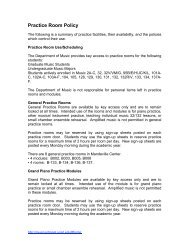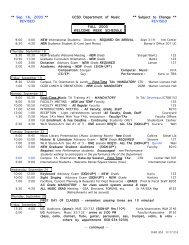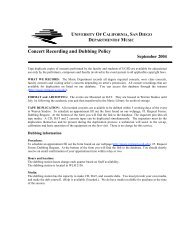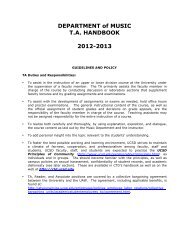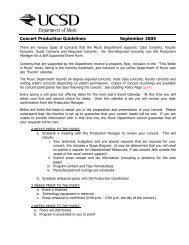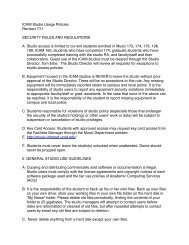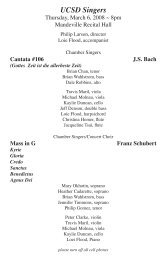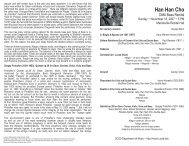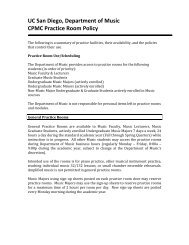UCSD Chamber Orchestra - UCSD Department of Music Intranet
UCSD Chamber Orchestra - UCSD Department of Music Intranet
UCSD Chamber Orchestra - UCSD Department of Music Intranet
Create successful ePaper yourself
Turn your PDF publications into a flip-book with our unique Google optimized e-Paper software.
Sunday, March 9, 2008, 3 p.m.<br />
Mandeville Auditorium<br />
<strong>UCSD</strong> <strong>Chamber</strong> <strong>Orchestra</strong><br />
Conductor- Ge<strong>of</strong>frey Gartner<br />
Clarinet- Robert Zelickman
Program<br />
Gioacchino ROSSINI<br />
(1792-1868)<br />
Introduction, Theme and variations<br />
for clarinet and orchestra<br />
********<br />
Two traditional Klezmer songs<br />
for clarinet and orchestra<br />
arranged by Zinovy Goro<br />
Happy Nigun<br />
2 nd Avenue Freilach<br />
********<br />
Manuel de FALLA<br />
(1876-1946)<br />
excerpts from El Amor Brujo<br />
Introduction y escena<br />
En la Cueva: La Noche<br />
El Aparecido-Danza del Terror<br />
El Circulo Mágico: Romance del Pescador<br />
Pantomima<br />
Danza ritual del Fuego<br />
I N T E R M I S S I O N
Film Screening:<br />
Un Chien Andalou (An Andalusian Dog) (1929)<br />
Director: Luis Buñuel<br />
Composers: Wagner, others<br />
(This film will be screened with its original sound.)<br />
**********<br />
Entr’acte (1925)<br />
Director: Rene Clair<br />
Composer: Erik Satie<br />
(The <strong>UCSD</strong> <strong>Chamber</strong> <strong>Orchestra</strong> will perform Satie’s film score live.)
Gioacchino Rossini-<br />
Introduction, Theme and Variations<br />
PROGRAM NOTES<br />
Little has been established about this engaging work. It is not mentioned in The New<br />
Grove Dictionary <strong>of</strong> <strong>Music</strong> and <strong>Music</strong>ians, which ordinarily provides a comprehensive<br />
listing <strong>of</strong> repertoire by all significant composers. As Kalman Bloch, former principal<br />
clarinetist <strong>of</strong> the Los Angeles Philharmonic for 46 years, observes, "There is great<br />
question as to whether Rossini actually composed this piece. It is thought that he wrote<br />
the tune and a student composed the variations. Nevertheless, it is one <strong>of</strong> the premier<br />
showpieces <strong>of</strong> its time: a popular tune followed by variations allowing the clarinetist to<br />
show <strong>of</strong>f tremendous technique and charm. Our repertoire could stand a few more <strong>of</strong><br />
these 'original' pieces." A graceful, operatic introduction makes the principal theme, once<br />
it appears, sound particularly light-hearted. Three successive variations are each a little<br />
more animated and a little more challenging for the soloist. A slow variation in the minor<br />
key follows a moment <strong>of</strong> mock seriousness, interrupting the humorous spirit. Before long,<br />
however, the upbeat character returns, in a final variation and coda that bring the soloist<br />
to the highest reaches <strong>of</strong> the clarinet register.<br />
Manuel de Falla-<br />
Excerpts from El Amor Brujo [Love, the Magician]<br />
-Introduction y escena [Introduction and Scene]<br />
-En la Cueva: La Noche [In the Cave: Night]<br />
-El Aparecido-Danza del Terror [The Ghost- Dance <strong>of</strong> Terror]<br />
-El Circulo Mágico: Romance del Pescador [The Magic Circle: the<br />
Fisherman’s Story]<br />
-Pantomima [Pantomime]<br />
-Danza ritual del Fuego [Ritual Fire Dance]<br />
“Gypsy scene from Andalusia” is the subtitle <strong>of</strong> the one-act ballet, El Amor Brujo<br />
(Love, the Magician), which the Spanish composer Manuel de Falla wrote in 1914/15 in<br />
response to a request from the Spanish dancer Pastora Imperio, who was looking for a<br />
piece in which she could sing as well as dance. When the piece proved an unexpected<br />
failure at its first performance in Madrid in 1915, de Falla withdrew the score and<br />
adapted it as an orchestral suite which, first heard in 1916, marked a change in the<br />
ballet’s fortunes. But the real breakthrough came with a production at the Théâtre du<br />
Trianon Lyrique, choreographed by La Argentina, in 1925. A further production at the<br />
Paris Opéra-Comique in 1928 marked the starting-point <strong>of</strong> the music’s international<br />
acclaim.<br />
In this drama <strong>of</strong> love and jealousy, the dead lover <strong>of</strong> the hot-blooded gypsy,<br />
Candelas, returns as a ghost in order to frustrate her new affair with her true love,
Carmelo. She cunningly contrives to exorcise the ghost and so salvage her relationship<br />
with Carmelo. De Falla portrays the Spanish nation in general as fiery, passionate and<br />
lively, leading lives essentially dominated by love, jealousy and mystical forces. The<br />
climax <strong>of</strong> the ballet is the Ritual Fire Dance, which is <strong>of</strong>ten performed as a solo dance<br />
number or played on its own in the concert hall.<br />
Un Chien Andalou (1929)<br />
Director: Luis Buñuel (1900-1983)<br />
Composer: Wagner, others<br />
Principal cast: Simone Mareuil, Pierre Batcheff, Luis Buñuel, Salvador Dalí<br />
Margarete Zander<br />
Synopsis: The dog in the title conspicuously fails to appear while, following radical eye<br />
surgery, Luis Buñuel directs his cynical gaze at human relations, drops dead donkeys into<br />
grand pianos, subjects Marist brothers to indignities, and manages in the nick <strong>of</strong> time to<br />
avoid a happy ending.<br />
Un Chien Andalou is the most famous <strong>of</strong> all Surrealist films. It launched the<br />
career <strong>of</strong> one <strong>of</strong> the 20 th century’s most original and provocative directors, Luis Buñuel.<br />
The extraordinary images (some <strong>of</strong> them still disturbing 75 years later) and the deliberate<br />
sabotage <strong>of</strong> the narrative conventions <strong>of</strong> cinema have been enormously influential. (It’s<br />
hard to imagine how the work <strong>of</strong> David Lynch would have been possible without the<br />
pioneering effects <strong>of</strong> Buñuel).<br />
In his biography, Buñuel describes the genesis <strong>of</strong> the film: “A few months later, I<br />
made An Andalusian Dog, which came from an encounter between two dreams. When I<br />
arrived to spend a few days at Dalí’s house in Figueras, I told him about a dream I’d had<br />
in which a long, tapering cloud sliced the moon in half, like a razor blade slicing through<br />
an eye. Dalí immediately told me he’d seen a hand crawling with ants in a dream he’d<br />
had the previous night. “And what if we started right there and made a film?” he<br />
wondered aloud.<br />
“Despite my hesitation, we soon found ourselves hard at work and in less than a<br />
week we had a script. Our only rule was very simple: No idea or image that might lend<br />
itself to rational explanation <strong>of</strong> any kind would be accepted. We had to keep all doors to<br />
the irrational open and keep only those moving images that surprised us, without trying to<br />
explain why. The amazing thing was that we never had the slightest disagreement; we<br />
spent a week <strong>of</strong> total identification. The filming took two weeks; there were only five or<br />
six <strong>of</strong> us involved, and most <strong>of</strong> the time no one quite knew what he was doing. “Stare out<br />
the window and look as if you’re listening to Wagner,” I remember telling Batcheff. “No,<br />
no – not like that. Sadder. Much sadder…”<br />
“The opening <strong>of</strong> The Andalusian Dog took place at the Ursulines, and was<br />
attended by le tout-Paris- some aristocrats, a sprinkling <strong>of</strong> well-established artists (among<br />
them Picasso, Le Corbusier, Cocteau…) and the surrealist group in toto. I was a nervous<br />
wreck. In fact, I hid behind the screen with the record player, alternating Argentinian
tangos with Tristan and Isolde. Before the show I’d put some stones in my pocket to<br />
throw at the audience in case <strong>of</strong> disaster…”<br />
Entr’acte (1925)<br />
Notes by Stephen Whittington<br />
Director: René Clair (1898-1981)<br />
Composer: Erik Satie (1866-1925)<br />
Principal cast: Francis Picabia, Erik Satie, Man-Ray, Marcel Duchamp, Jean Börlin<br />
Synopsis: Erik Satie and Francis Picabia assassinate the audience with a cannon, Marcel<br />
Duchamp and Man-Ray play chess, and a camel-drawn hearse leads everyone on a frantic<br />
chase.<br />
The film Entr’acte was made to be screened during the interval <strong>of</strong> the ballet<br />
Relâche, created by Francis Picabia, with music by Erik Satie, which was premiered by<br />
the Swedish Ballet in Paris in 1925. In a typical Dada-Surrealist provocation, the title <strong>of</strong><br />
the ballet means ‘No Performance Tonight.’ When the smart set <strong>of</strong> Paris showed up in<br />
their evening dress for the first performance, they found the theatre locked. Assuming the<br />
whole thing was a joke at their expense, they went home. In fact, by a curious but entirely<br />
unforeseen coincidence, the star <strong>of</strong> the show, Jean Börlin (who also appears in Entr’acte)<br />
was sick and the performance really had been cancelled. It took a great deal <strong>of</strong> effort to<br />
persuade the public to return several nights later for the actual first performance.<br />
Entr’acte is a virtuoso piece <strong>of</strong> film making, playing with the conventions <strong>of</strong><br />
silent film (concluding with the obligatory chase sequence) in a highly inventive way.<br />
Before the film proper, there is a short prologue which was originally placed after the<br />
overture to the ballet, featuring Satie (with trademark bowler hat and umbrella), and<br />
Picabia.<br />
The film opens with a series <strong>of</strong> visual puns involving chimneys, balloons, boxing<br />
gloves and city lights. There is a false ending when Jean Börlin sets fire to his hair with<br />
matches. Man-Ray and Marcel Duchamp appear playing chess; a ballerina is filmed from<br />
an extreme low angle- as the camera pans up she is shown to bear a striking resemblance<br />
to Satie, complete with beard; Picabia appears later with a gun with which he assassinates<br />
Börlin, who is given a mock funeral from which he emerges alive.<br />
The vagaries <strong>of</strong> accompanying silent film (variability <strong>of</strong> projection speed, prints<br />
<strong>of</strong> the film that vary in length by several minutes) are perfectly coped with by Satie’s<br />
score, which consists largely <strong>of</strong> a collection <strong>of</strong> modules that can be repeated as many<br />
times as needed to match the film. Satie worked closely with the director, René Clair,<br />
who later declared that the score was ‘the most perfect example <strong>of</strong> film music.’ There is<br />
in fact some speculation, as yet unsubstantiated, that Satie worked as a cinema pianist in<br />
the early years <strong>of</strong> the 20 th century. Silent movie accompanists regularly pillaged<br />
(‘sample’, one might say in modern terms) the popular classics for material. Satie<br />
parodies the famous Funeral March by Chopin for the bizarre funeral scene.<br />
Notes by Stephen Whittington
The <strong>UCSD</strong> <strong>Chamber</strong> <strong>Orchestra</strong><br />
Flute/piccolo Minji Cho<br />
Flute Ryan Hayes, Michelle Saldana<br />
Oboe Laura Paget, Carina Rammelkamp<br />
Clarinet Christopher Chen, Dipika Gopal, Ana Kasirer-Freide, Lisa Tulathimutte<br />
Bassoon Daiki Takekawa<br />
Horn Justin Honsinger, Bassem Shoucri, Amanda Tabor<br />
Trumpet Melody Chang, Wilson Kwan<br />
Trombone Andrew Davis<br />
Percussion Jennica Billins, Brian Nuyen, Ross Karre<br />
Timpani Ross Karre<br />
Piano Brian Nuyen<br />
1st Violin Lisa Nguyen (concertmaster), Joyce Chu, Kate Kim, Michelle Kong,<br />
Angela Ledl, Kimmie Riskas, Matus Telgarsky<br />
2 nd Violin Jennifer Au (principal), Kaitlen Conner, Jason Fong, Minji Kim, Elaine Lee,<br />
Norman Kuo, Susan Mahabady, Leslie Manjarrez, Carolina Margarito,<br />
Emily Witham, Kevin Wu<br />
Viola Matthew Li (principal), Mengchieh Chuang, Hanna Ellingsen,<br />
Christina Hanson, Kimberly Verrell<br />
Cello Jesse Alm (principal), Robert Dufau, Ting Shen,<br />
Stef von Huben, Siobhan Williams<br />
Bass Han-han Cho, Tom Ferguson



